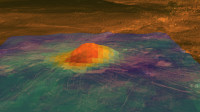A new episode of active volcanism on Venus?
2 December 2012
For decades, planetary scientists have debated whether Venus possesses active volcanoes. The latest twist to the tale is provided by data sent back from ESA's Venus Express orbiter, revealing unexplained major changes in the amount of sulphur dioxide gas above the planet's dense cloud layer.
 |
|
Is Venus volcanically active? |
Since Earth and Venus are similar in size and mass, and both planets formed around the same time and in the same region of the Solar System, one might expect them to virtual twins. However, Venus is enveloped by a thick blanket of clouds, composed mainly of sulphuric acid droplets. Hurricane force winds at the cloud tops sweep around the planet in only four days – a phenomenon known as super-rotation.
Beneath the clouds, the carbon-dioxide-rich atmosphere has a density 90 times greater than on Earth. This suffocating atmosphere acts like a greenhouse, trapping solar heat and causing the surface temperature to soar to around 460 degrees Celsius.
Although it is the closest planet to Earth and it has been visited by numerous spacecraft, Venus retains many mysteries. One enduring question is whether there are any active volcanoes.
 |
|
Surface warmth on a volcano on Venus. Credit: ESA/NASA/JPL |
Radar imagery has revealed more than 1000 volcanic structures and evidence of possible periodic resurfacing of the planet by floods of lava. By studying emission of infrared radiation from lava flows around a volcanic mountain, Venus Express has also found indirect evidence that volcanism has taken place within the last 2.5 million years. However, no definitive proof of current volcanic eruptions has yet been found, and the debate continues to rage.
The latest contribution to the investigation into active Venusian volcanism comes from the SPICAV-UV spectrometer on board Venus Express, which has been in orbit around the planet since 2006. By studying the SPICAV data, a team of scientists from France and Russia has discovered an unusual change in the amount of sulphur dioxide (SO2) gas in the upper atmosphere.
 |
|
Rise and fall of sulphur dioxide. |
The SPICAV data show that the concentration of SO2 above the main cloud deck increased slightly to about 1000 parts per billion by volume (ppbv) between 2006 and 2007, but then steadily decreased over the next five years, reaching only 100 ppbv by 2012. This is very reminiscent of a pattern observed by Pioneer Venus during the 1980s, the only other multi-year dataset of SO2 measurements.
Since Venus does not experience any seasons, the authors of the paper in Nature Geoscience suggest two possible explanations: periods of active volcanism, or long-term variability in the general circulation of the atmosphere.
"Sulphur dioxide is a key indicator of the processes taking place in the upper atmosphere of Venus," said Emmanuel Marcq, of LATMOS, Université de Versailles-Saint-Quentin, France, the lead author of the paper.
"SO2 is known to be an important, and constant, constituent of the lower atmosphere of Venus. A steady supply of SO2 to high levels is provided by air rising from the hot, lower atmosphere. When it gets above the clouds, SO2 is rapidly destroyed by solar UV light, so it has a very short life, less than half a day, in the upper atmosphere of Venus."
"This means that the only explanation for a marked rise and fall in SO2 concentration at an altitude of 70 km is an enhanced injection of enriched gas from lower levels, beneath the clouds."
Although SO2 is an important constituent of volcanic outgassing, the authors of the paper suggest that the increase observed by Venus Express may be the result of a plume of heated gases rising to high altitudes, rather than a direct injection of SO2.
"An explosive volcanic eruption, rather like a more powerful version of the 1991 Mt. Pinatubo eruption on Earth, could act like a piston, blasting a column of gas up to these levels," said co-author Jean-Loup Bertaux, Principal Investigator for Venus Express SPICAV instrument that made the detections. "This extra convection could carry SO2 above the clouds and temporarily increase its concentration."
On the other hand, the amount of SO2 in the lower atmosphere has remained remarkably stable at very high levels over more than a decade, and there has been no evidence of an increase in thermal emission from the planet's surface to coincide with the changes observed by SPICAV. This opens up the possibility that the increased levels of SO2 above the clouds could have been caused by a change in the global atmospheric circulation which increased the movement of gases from the lower to upper atmosphere.
"During periods of scarce SO2, there is usually a greater amount above the poles of Venus than near the equator," said Emmanuel Marcq. "However, this distribution pattern was reversed in our 2006-2007 data when SO2 was abundant. This suggests that there may have been stronger advection (upwelling) near the equator of air from the lower, SO2 -enriched regions of the atmosphere until 2007. Over the same period of time, the mean UV brightness of the cloud tops also declined.
"It is possible that long-term variations occur in the atmospheric circulation, resulting in injections of SO2 from lower levels and changes in cloud chemistry, revealed by observations of UV absorption."
"The atmospheric circulation of the planet is not yet fully understood," said Jean-Loup Bertaux, "but we believe there may be two simple Hadley cells in which air rises at the equator, spreads out at cloud level towards the poles, then sinks toward the surface, before flowing back to the equator.
"Whichever explanation is correct, it seems that the shift in SO2 concentrations between the poles and equator, as well as the periodic rise and fall at high altitudes, are consistent with fluctuations in the SO2 supply from the lower atmosphere at low latitudes."
"There are very few opportunities to search for evidence of active volcanism on Venus," said Håkan Svedhem, ESA's project scientist for Venus Express. "Since there are no other spacecraft studying Venus at the present time, Venus Express is the only means to find evidence for such activity. Although it is not yet possible to explain the results, the SPICAV data are very intriguing and show once again the similarities in the physical processes that occur on the terrestrial planets."
Notes for editors
The results presented in this article are reported in "Variations of sulphur dioxide at the cloud top of Venus's dynamic atmosphere" by Emmanuel Marcq, Jean-Loup Bertaux, Franck Montmessin and Denis Belyaev, published in the 3 December issue of Nature Geoscience.
Europe's first mission to Venus, Venus Express was launched from Baikonur Cosmodrome on 9 November 2005 on a Soyuz-Fregat launcher. It was inserted into Venus orbit on 11 April 2006. Venus Express orbits the planet in a 24 h period polar orbit. Its payload includes a combination of spectrometers, spectro-imagers, and imagers covering a wavelength range from ultraviolet to thermal infrared, a plasma analyser and a magnetometer.
Venus Express was designed to be the first spacecraft to perform a global investigation of the Venusian atmosphere and of the plasma environment. Venus Express reused designs from Mars Express and also employed spare instruments from Mars Express and Rosetta. The "Express" in its name denotes the accelerated pace with which it went through the process from design to launch, taking less than four years.
Contacts
Emmanuel Marcq
Laboratoire Atmosphères, Milieux, Observations Spatiales (LATMOS)
Université de Versailles-Saint-Quentin, France
E-mail : Emmanuel.Marcq![]() latmos.ipsl.fr
latmos.ipsl.fr
Phone: +33-1-80-28-52-83
Jean-Loup Bertaux
Laboratoire Atmosphères, Milieux, Observations Spatiales (LATMOS)
Université de Versailles-Saint-Quentin, France
E-mail: jean-loup.bertaux![]() latmos.ipsl.fr
latmos.ipsl.fr
Phone: +33-1-80-28-50-62, +33-6-80-73-08-70
Håkan Svedhem
ESA Venus Express Project Scientist
Research and Scientific Support Department
Science and Robotic Exploration Directorate
ESA, The Netherlands
E-mail: H.Svedhem![]() esa.int
esa.int
Phone: +31-71-565-3370




